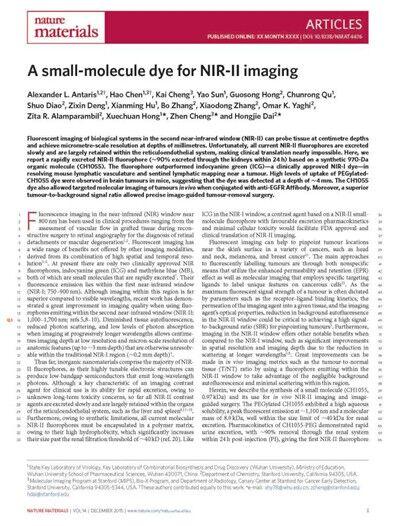On November 23rd, Nature Materials published online the result of the research collaboration between Wuhan University and Stanford University on small-molecule dye for NIR-II imaging.
The research, named “a small-molecule dye for NIR-II imaging”, led to the successful synthesis of CH1055, a small-molecule dye for NIR-II imaging that could be used to mark various types of biomolecules and be biologically metabolized, for the first time in history.
The research was done collaboratively by the research group led by Professor Hong Xuechuan of the School of Pharmaceutical Sciencesof WHU and another led by Professor Cheng Zhenof Molecule Imaging Program at Stanford University and Professor Dai Hongjie from the Department of Chemistry of Stanford University. Alexander L. Antaris, a doctoral student in the cooperative educational program by WHU and Stanford University, and Chen Hao, a doctoral student in Grade 2011 of the School of Pharmaceutical Sciences, are both the first authors of the paper, with Wuhan University placed the first among the authors’ affiliations.
Fluorescence imaging, widely used in biological researches, serves to distinguish normal tissues from abnormal onesso as to provide surgical guidance. Compared with visible light and NIR-Ifluorescence imaging, NIR-II imaging boasts better image quality and has, therefore, become a hot spot in researches on in vivo fluorescence imaging in recent years.
CH1055 outperformed ICG, an ordinary NIR-1 dye, with its ability to produce images with greater depth and resolution. Moreover, images of sentinel lymph node, etc., are also superior in quality when CH1055 is employed.
For the first time, researchers successfully conducted the incision of mouse subcutaneous tumor with the help of NIR-II imaging, demonstrating the huge potential of CH1055 and CH1055 fluorescence imaging in biomedical sciences. Due to its high biological compatibility, CH1055 enjoys great potential in terms of its clinical application.

(Edited by Sijia Hu)


